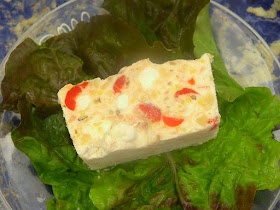We scraped out what we could and the boys came up with the idea of going outside to use a hose to rinse out the pots and pans. It is compost, after all. After refrigerating what we could, we washed glasses in a pan and dumped the remains in a toilet and put as much in the dishwasher as we could, optimistically assuming it would be usable the next day. We left things to soak overnight; I sprayed for ants liberally around the kitchen. And then we shut the door and put it out of our minds until we could call a plumber the next morning. Yes, all's well that ends well. Potato peels were the culprit and I received a brief lecture on running water long enough when using my disposal.
I hope your dinner was as delicious as ours. Surprisingly, one of my sons had asked what I was serving for dessert and when I said I had decided on a pumpkin flan, he asked if I would make a bread pudding. Not something I would normally do when I am serving cloverleaf rolls AND stuffing, but saw no reason to say no. He had it recently at a restaurant and wanted to taste mine- which had to be better, right? It was. It has an interesting history and I will give you the recipe next week as I took a super photo of it.
Anyway, I have mentioned before that every Thanksgiving my family asks me to include a brussel sprout dish that has now become a tradition. I have no idea where I originally found the recipe, probably some cookbook or magazine and I have even less of an idea why I would ever serve this dish as my family is not overly fond of brussel sprouts. But back in the days when I would have 12 to 16 people for dinner every holiday that came along, I was desperate for new ways to make vegetables. It was such a hit now my family insists upon it.
It has lots of Parmesan, garlic, prosciutto and cream and is altogether delicious. You can get the kids to slice the sprouts and then turn on the kitchen fan full blast as it emits a strong odor while cooking. What I like is I can make it the day before, let it cool a bit, cover and refrigerate and the next day bring it to room temperature and bake. Trust me, you will adore this.
Brussel Sprouts Parmesan
Ingredients:1 stick unsalted butter
5 cloves garlic, crushed
4 ounces prosciutto, cut in slivers
2 pounds brussel sprouts, trimmed and shredded
3 tablespoons flour
1 1/2 cups whipping cream
1 cup light cream
1/2 cup sweet Marsala
1 teaspoon nutmeg, freshly grated
salt and pepper
1 1/2 cups freshly grated Parmesan
Method:Preheat oven to 350°.
Melt butter and add garlic and prosciutto. Cook 4 minutes. Add sprouts and cook 4 minutes. Stir in the flour, both creams and the Marsala. Reduce heat and simmer for 5 minutes. Add nutmeg, salt and pepper. Stir in 1 cup of the Parmesan and mix until it is melted. Pour into a casserole and top with the remaining Parmesan.
You may refrigerate overnight at this point.
Bring to room temperature before baking. Bake for 20 minutes.
Serves 8-10







 Maldon Sea Salt:
Maldon Sea Salt: